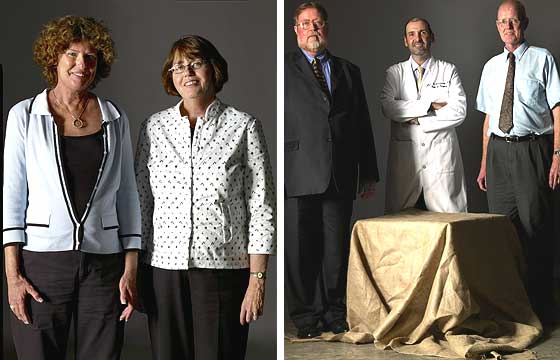
Patients: Terence Boyle, 53, lawyer; Brendan Boyle, 52, reference librarian; Patricia Spencer, 52, nurse; Mary Jane DiPaolo, 48, division director at Catholic Charities
Doctor: Dr. Alan Benvenisty, director of renal-transplantation program, St. Luke’s–Roosevelt Hospital Center
Benvenisty: The family has polycystic kidney disease, a heritable illness that can lead to renal failure, which can affect your heart, mental status, electrolytes, and even result in sudden death—it’s one of the more deadly genetic diseases. Their father had the disease. He died in his late thirties and passed it on to his children. Usually, not all the children will get it, but in this case, they all got it. I’ve performed six transplants on them. I’ve known them for 22 years.

1. Conductor, 89, With Heart Problems, Too Old and Sick for Surgery2. Firefighter Separates Spine From Skull3. Taxi Driver Survives Testicular Cancer4. Baby With Severe Back and Rib Problems5. College Student Going Blind in Both Eyes6. Factory Worker Loses Hands7. Hockey-Mad 5-Year-Old Has Potentially Fatal Tumor8. Woman Carrying Triplets Has Torn Aorta9. Woman Needs Heart and Lung Transplant10. Hip-Replacement Complications May Cost a Woman Her Leg11. Four Siblings With Potentially Fatal Kidney Disease

Terence: I was first diagnosed in 1972, when I was 19 years old. I had a summer job at a General Motors assembly plant and they gave me the perfunctory physical and one of the things they did was take my blood pressure, which was very high. The doctor had me fill out a form, and I put down that my father had died from polycystic kidney disease. He suggested that I see another doctor, and eventually we were all tested—my brother, Brendan; his twin sister, Patricia; and my youngest sister, Mary Jane. There was no indication that Brendan and Patricia had the disease. Mary Jane had the disease but she showed no symptoms.
Benvenisty: What happens is, as the patient ages, cysts gradually appear on the kidney and enlarge over time. You can usually diagnose it by the time the patient is 25. In this particular family, the kidneys grew to an impressive size. Terence’s kidneys were massive—each one was more than 20 pounds. A normal kidney weighs about a quarter of a pound, half a pound at the most. Mary Jane’s kidney was 26 pounds. Brendan’s kidneys are about three or four times normal size. Pat’s were not impressively enlarged.
Terence: I’ve had four kidney transplants. I’m pretty sure I’m the patient Dr. Benvenisty has operated on the most—unless someone else has come along in the meantime.
Benvenisty: Terry’s first transplant was in 1985. Ultimately, the transplant failed. Then in August of 1987, he had a second transplant. This one was a perfect match. But many kidneys fail over time.
Terence: And this particular kidney—the second one—was never ideal. A kidney has two arteries and a week after the transplant, the bottom artery collapsed. So I was really operating for those eleven years on two-thirds of one kidney.
Benvenisty: In 1998, I transplanted him with a kidney from his former wife. At the same time, I removed the second transplant kidney to make room for the third one. Then that didn’t do well. He developed thrombotic microangiopathy, an inflammatory condition of the blood vessels in the kidney that can cause kidney damage. His last transplant was in 2002. Brendan and Patricia’s surgeries, in 1997 and 1998, were pretty routine. They had one kidney transplant each.
Mary Jane: I was diagnosed when I was 15 and had kidney failure at 46, in 2004. My brothers and sister were all shocked and disappointed. I guess everybody thought it wasn’t going to happen to me ’cause I’m the baby. It was a big disappointment for everyone because no one was spared.
Benvenisty: Mary Jane was very ill with uremia when she finally got her transplant. Uremia is when your kidneys are not filtering things properly and toxins build up. She was very weak, had shortness of breath, was anemic, and was losing weight. I had to remove the kidney at the same time I did the transplant. Most of the time, the native kidneys stay in their place in the flank and the new kidney is placed right above the groin. But in this particular case, the kidneys grew so large that there was no room.
Terence: When each of them got their transplants, I was in the hospital that day.
Benvenisty: The whole family is very sensitive to medication. Terry and Mary Jane developed thrombotic microangiopathy. It’s thought to be a reaction to one of the medications. I was on guard with Mary Jane because Terry had thrombotic microangiopathy, so when it happened to her, I knew how to deal with it.
Terence: I think the fact that he was so familiar with our family history made him better able to treat my brother and sisters.
Mary Jane: By having siblings with the same disease, I wasn’t so frightened. I saw that people go through it and recover and continue working and have a normal life.
Benvenisty: Years ago, Terence probably would not have made it, much like his father didn’t. Pat has had very few complications and is active and doing well, and other than a hernia operation, Brendan is relatively healthy, too. They still have both of their native kidneys. Mary Jane had a few complications after the transplant, but now it seems that she’s back on track. This family illustrates that medicine isn’t just about successes, but it’s about rough times and getting people through them.
Brendan: We have camaraderie. Like being in the army together or something. BACK TO THE BEGINNING: Conductor, 89, Too Old and Sick For Surgery